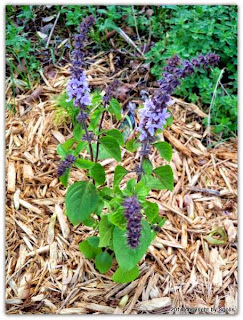Creeping rosemary herb is a delicious and fragrant herb that will cover your ground quickly with its trailing stems. You can grow creeping rosemary on a slope, in a container, on in a rock garden provided the plant has ample space to grow. Fully grown rosemary will trail to three feet.
A few years ago I decided to grow rosemary in a metal wheelbarrow because I liked how I could move the wheelbarrow around to different areas of my yard. If we were having friends over to relax on the patio I would move the fragrant and abundant rosemary wheelbarrow close to the outdoor living space and all could enjoy the aroma.
The rosemary grew in quickly and consumed the wheelbarrow to the point that I need to prune the stems. I also needed to water more because the wheelbarrow dried out too quickly. Planting trailing rosemary in a wheelbarrow was eye-appealing however I did need to maintain the plant.
The best plant container for this trailing rosemary would be heavy ceramic or clay large freestanding pots, self-watering hanging containers or large window boxes.
Growing Tips for Creeping Rosemary
Choose a garden site where the soil is well-drained, and there is a minimum of 6 hours of full sun per day and part sun during the hottest part of the day. Soil should be evenly moist but not wet. Water rosemary plants, in the morning throughout the growing season.
For small yards grow creeping rosemary in containers gardens. As long as you provide the herb with ample sunlight and medium soil as well as hydration when needed you will be able to successfully grow creeping rosemary in a patio container. You will need to plant in a container that allows the rosemary to creep; consider a hanging container or large pot, one that will allow the rosemary to cascade down the sides.
 |
| Mature Creeping Rosemary |
When you shop for containers for rosemary make sure that they have adequate drainage
holes. Check your containers and if you
have none or if you have small holes you can make holes with your drill. Improve your water drainage by adding pea
gravel to the bottom of the container.
I usually add an inch and a half. The gravel is a good way to prevent the roots from getting wet. Then mix your potting soil with some compost or manure and fill your container. Stop the soil an inch from the top. This will allow the water to stay in the pot and not fall over the rim.
I usually add an inch and a half. The gravel is a good way to prevent the roots from getting wet. Then mix your potting soil with some compost or manure and fill your container. Stop the soil an inch from the top. This will allow the water to stay in the pot and not fall over the rim.
Plant the rosemary by digging a hole that is the same size as the nursery container. Set the rosemary herb in the hole and backfill the soil. Firm the soil around the stem and water so that the soil is evenly moist.
Creeping rosemary is a fast-growing evergreen
herb. The entire plant; leaves, stems and pale blue flowers are very
fragrant which is why I love this herb. When the herb blooms in
August the blue flowers cover the stems. Creeping rosemary grows
well in zones 7, and 8,9 and is hardy to 20 F. Before a hard freeze
brings rosemary indoors and continues growing by a southern window.
.
·
Keep your creeping rosemary healthy by
watering in the morning with drip irrigation or a soaker hose. Also, apply
organic mulch around the plant to aid in keeping the soil moist and deter weed
growth.
Fertilize in spring and early summer with
organic herb food. Prune rosemary after the
flowers have bloomed.
Creeping rosemary can be trained to grow up a
trellis.
Rosemary has many uses; you can cook with the
leaves, or make potpourri. I like to cut springs of rosemary for my garden wreaths,
herb arrangements, and my natural rosemary soap. The aromatic rosemary
has an invigorating fragrance that appeals to my senses.





















